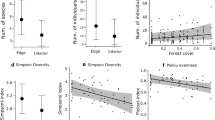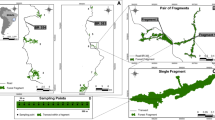Abstract
The reliability of ants as bioindicators of ecosystem condition is dependent on the consistency of their response to localised habitat characteristics, which may be modified by larger-scale effects of habitat fragmentation and loss. We assessed the relative contribution of habitat fragmentation, habitat loss and within-patch habitat characteristics in determining ant assemblages in semi-arid woodland in Queensland, Australia. Species and functional group abundance were recorded using pitfall traps across 20 woodland patches in landscapes that exhibited a range of fragmentation states. Of fragmentation measures, changes in patch area and patch edge contrast exerted the greatest influence on species assemblages, after accounting for differences in habitat loss. However, 35% of fragmentation effects on species were confounded by the effects of habitat characteristics and habitat loss. Within-patch habitat characteristics explained more than twice the amount of species variation attributable to fragmentation and four times the variation explained by habitat loss. The study indicates that within-patch habitat characteristics are the predominant drivers of ant composition. We suggest that caution should be exercised in interpreting the independent effects of habitat fragmentation and loss on ant assemblages without jointly considering localised habitat attributes and associated joint effects.




Similar content being viewed by others
References
Abensperg–Traun M, Smith GT, Arnold GW et al (1996) The effects of habitat fragmentation and livestock–grazing on animal communities in remnants of gimlet Eucalyptus salubris woodland in the Western Australian wheatbelt. 1. Arthropods. J Appl Ecol 33:1281–1301
Andersen AN (1995) A classification of Australian ant communities, based on functional groups which parallel plant life forms in relation to stress and disturbance. J Biogeogr 22:15–29
Andersen AN (1997) Using ants as bioindicators: multiscale issues in ant community ecology. In: Conservation Ecology 1:8. http://www.ecologyandsociety.org/vol1/iss1/art8. Cited 17 December 2004
Andersen AN, Majer JD (2004) Ants show the way Down Under: invertebrates as bioindicators in land management. Front Ecol Environ 2:291–298
Andrén H (1994) Effects of habitat fragmentation on birds and mammals in landscapes with different proportions of suitable habitat: a review. Oikos 71:355–366
Bestelmeyer BT, Wiens JA (2001) Ant biodiversity in semiarid landscape mosaics: the consequences of grazing vs. natural heterogeneity. Ecol Appl 11:1123–1140
Bhar R, Fahrig L (1998) Local vs. landscape effects of woody field borders as barriers to crop pest movement. In: Conservation Ecology 2:3. http://www.ecologyandsociety.org/vol2/iss2/art3. Cited 22 December 2005
Borcard D, Legendre P, Drapeau P (1992) Partialling out the spatial component of ecological variation. Ecology 73:1045–1055
Bowman DMJS, Prior LD (2004) Impact of Aboriginal landscape burning on woody vegetation in Eucalyptus tetrodonta savanna in Arnhem Land, northern Australia. J Biogeogr 31:807–817
Brown JH, Kodric–Brown A (1977) Turnover rates in insular biogeography: effects of immigration on extinction. Ecology 58:445–449
Chust G, Pretus JL, Ducrot D et al (2003) Identification of landscape units from an insect perspective. Ecography 26: 257–268
Cushman SA, McGarigal K (2002) Hierarchical, multi–scale decomposition of species–environment relationships. Landsc Ecol 17:637–646
Davies KF, Margules CR, Lawrence JF (2000) Which traits of species predict population declines in experimental forest fragments? Ecology 81:1450–1461
Davies KF, Melbourne BA, Margules CR (2001) Effects of within– and between–patch processes on community dynamics in a fragmentation experiment. Ecology 82:1830–1846
Davis–Carter JG, Sheppard DC (1993) Redistribution of metals and nutrients by fire ants in a flue dust contaminated pasture. Soil Biol Biochem 25:747–750
de Bruyn LAL (1993) Ant composition and activity in naturally–vegetated and farmland environments on contrasting soils at Kellerberrin, Western Australia. Soil Biol Biochem 25:1043–1056
Debinski DM, Holt RD (2000) A survey and overview of habitat fragmentation experiments. Cons Biol 14:342–355
Didham RK, Lawton JH (1999) Edge structure determines the magnitude of changes in microclimate and vegetation structure in tropical forest fragments. Biotropica 31:17–30
Fahrig L (1997) Relative effects of habitat loss and fragmentation on population extinction. J Wildl Manage 61:603–610
Fahrig L (2003) Effects of habitat fragmentation on biodiversity. Ann Rev Ecol Evol Syst 34:487–515
Fensham RJ, Fairfax RJ, Archer SR (2005) Rainfall, land use and woody vegetation cover change in semi-arid Australian savanna. J Ecol 93:596–606
Foley P (1997) Extinction models for local populations. In: Hanski IA, Gilpin ME (eds) Metapopulation biology: ecology, genetics and evolution. Academic Press, San Diego
Gardner SM, Cabido MR, Valladares GR et al (1995) The influence of habitat structure on arthropod diversity in Argentine semi-arid Chaco forest. J Veg Sci 6:349–356
Greenslade PJM (1964) Pitfall trapping as a method for studying populations of Carabidae (Coleoptera). J Anim Ecol 33:301–310
Greenslade PJM, Greenslade P (1977) Some effects of vegetation cover and disturbance on tropical ant fauna. Insectes Soc 24:163–182
Greenslade PJM, Halliday RB (1983) Colony dispersion and relationships of meat ants Iridomyrmex purpureus and allies in an arid locality in South Australia. Insectes Soc 30:82–99
Guinto DF, Saffigna PG, Xu Z et al (1999) Soil nitrogen mineralisation and organic matter composition revealed by 13C NMR spectroscopy under repeated prescribed burning in eucalypt forests of south-east Queensland. Aust J Soil Res 37:123–135
Hansen RA (2000) Effects of habitat complexity and composition on a diverse litter microarthropod assemblage. Ecology 81:1120–1132
Hanski I (1999) Metapopulation ecology. Oxford University Press, Oxford
Hobbs R (2001) Synergisms among habitat fragmentation, livestock grazing, and biotic invasions in Southwestern Australia. Cons Biol 15:1522–1528
Hoffmann BD, Andersen AN (2003) Responses of ants to disturbance in Australia, with particular reference to functional groups. Austr Ecol 28:444–464
Hölldobler B, Wilson EO (1990) The ants. Springer–Verlag, Berlin
Jackson GP, Fox BJ (1996) Comparison of regeneration following burning, clearing or mineral sand mining at Tomago, NSW. II. Succession of ant assemblages in a coastal forest. Aust J Ecol 21:200–216
Jellinek S, Driscoll DA, Kirkpatrick JB (2004) Environmental and vegetation variables have a greater influence than habitat fragmentation in structuring lizard communities in remnant urban bushland. Austr Ecol 29:294–304
Jules ES, Shahani P (2003) A broader ecological context to fragmentation: why matrix habitat is more important that we thought. J Veg Sci 14:459–464
Lassau SA, Hochuli DF (2004) Effects of habitat complexity on ant assemblages. Ecography 27:157–164
Laurance WF, Bierregaard RO Jr (eds) (1997) Tropical forest remnants: ecology, management, and conservation of fragmented communities. University of Chicago Press, Chicago
Lawton JH (1987) Are there assembly rules for successional communities In: Gray AJ, Crawley MJ, Edwards PJ (eds) Colonisation, succession and stability. Blackwell Scientific Publications, Oxford
Lindenmayer DB, Margules CR, Botkin D (2000) Indicators of biodiversity for ecologically sustainable forest management. Cons Biol 14:941–950
Lunt ID, Spooner PG (2005) Using historical ecology to understand patterns of biodiversity in fragmented historical landscapes. J Biogeogr 32:1859–1873
MacArthur RH, Wilson EO (1967) The theory of island biogeography. Princeton University Press, Princeton
McGarigal K, Marks BJ (1995) FRAGSTATS: spatial pattern analysis program for quantifying landscape structure. USDA Forest Service, Pacific Northwest Station, GTR–351, Portland
McIntyre S, Barrett GW (1992) Habitat variegation, an alternative to fragmentation. Cons Biol 6:146–147
Mac Nally R, Bennett AF, Horrocks G (2000) Forecasting the impacts of fragmentation. Evaluation of species–specific predictions of the impact of habitat fragmentation on birds in the box–ironbark forests of central Victoria, Australia. Biol Conserv 95:7–29
Manly BFJ (1991) Multivariate statistical methods: a primer. Chapman and Hall/CRC, Boca Raton
Martin TG, Green JL (2002) Wildlife and core conservation areas In: McIntyre S, McIvor JG, Heard KM (eds) Managing and conserving grassy woodlands. CSIRO Publishing, Collingwood
Melbourne BA (1999) Bias in the effect of habitat structure on pitfall traps: an experimental evaluation. Aust J Ecol 24: 228–239
Niemelä J (2001) Carabid beetles (Coleoptera: Carabidae) and habitat fragmentation: a review. Eur J Entomol 98:127–132
Økland RH (1999) On the variation explained by ordination and constrained ordination axes. J Veg Sci 10: 131–136
Ottonetti L, Tucci L & Santini G (2006) Recolonization patterns of ants in a rehabilitated lignite mine in central Italy: potential for the use of Mediterranean ants as indicators of restoration processes. Restor Ecol 14: 60–66
Pharo EJ, Lindenmayer DB, Taws N (2004) The effects of large–scale fragmentation on bryophytes in temperate forests. J Appl Ecol 41:910–921
Queensland Department of Natural Resources and Water (2003) Land cover changes in Queensland 1999–2003: a statewide land and tree study report (SLATS). Queensland Department of Natural Resources and Water, Brisbane
Ross KA, Fox BJ, Fox MD (2002) Changes to plant species richness in forest fragments: fragment age, disturbance and fire history may be as important as area. J Biogeogr 29:749–765
Russell–Smith J, Stanton P (2002) Fire regimes and fire management of rainforest communities across northern Australia In: Bradstock RA, Williams JE, Gill, AM (eds) Flammable Australia: the fire regimes and biodiversity of a continent. Cambridge University Press, Cambridge
Samways M, Osborn R, Carliel F (1997) Effect of a highway on ant (Hymenoptera: Formicidae) species composition and abundance, with a recommendation for roadside verge width. Biodivers Conserv 6:903–913
Sattler PS, Williams RD (eds) (1999) The conservation status of Queensland’s bioregional ecosystems. Environmental Protection Agency, Brisbane
Saunders DA, Hobbs RJ, Margules CR (1991) Biological consequences of ecosystem fragmentation: a review. Cons Biol 5:18–32
Schoereder JH, Sobrinho TG, Ribas CR et al (2004) Colonization and extinction of ant communities in a fragmented landscape. Aust Ecol 29:391–398
Sobrinho TG, Schoereder JH, Sperber C F et al (2003) Does fragmentation alter species composition in ant communities (Hymenoptera: Formicidae)? Sociobiol 42:329–342
Spence JR, Niemelä JK (1994) Sampling carabid assemblages with pitfall traps: the madness and the method. Can Entomol 126: 881–894
Suarez AV, Bolger DT, Case TJ (1998) Effects of fragmentation and invasion on native ant communities in coastal southern California. Ecology 79:2041–2056
ter Braak CJF, Šmilauer P (2002) CANOCO reference manual and CanoDraw for Windows users guide: software for canonical community ordination. Microcomputer Power, New York
Tews J, Brose U, Grimm V et al (2004) Animal species diversity driven by habitat heterogeneity/diversity: the importance of keystone structures. J Biogeogr 31:79–92
Tscharntke T, Steffan-Dewenter I, Kruess A et al (2002) Characteristics of insect populations on habitat fragments: a mini review. Ecol Res 17:229–239
Vanderwoude C (1999) An evaluation of ant communities as indicators of ecological change resulting from anthropogenic disturbance in spotted gum (Corymbia variegata) forests in south-east Queensland. Dissertation, University of New England
Vanderwoude C, Andersen AN, House APN (1997) Community organization, biogeography and seasonality of ants in an open forest of south-eastern Queensland. Aust J Zool 45:523–537
Wiens JA (1997) Metapopulation dynamics and landscape ecology In: Hanski IA, Gilpin ME (eds) Metapopulation biology: ecology, genetics and evolution. Academic Press, San Diego
Wu J, Shen W, Sun W et al (2002) Empirical patterns of the effects of changing scale on landscape metrics. Landsc Ecol 17:761–782
Acknowledgements
This research was conducted as part of Land and Water Australia Project QNR 28, with financial support from Queensland Department of Natural Resources and Water. We thank landowners for property access and Landcare members for assistance with locating study sites. We thank David Taylor, Scott Swift, Michael Kraus, Melanie Venz, Giselle Whish, Jian Wang, Tonya Hardaker and David Osborne who provided data for this study and we are grateful to Chris Burwell, Rudi Kohout and Alan Andersen for assistance with species identification. We thank Alan Andersen and two anonymous referees for their comments on the manuscript.
Author information
Authors and Affiliations
Corresponding author
Additional information
The State of Queensland's right to retain a non-exclusive, royalty free license in and to any copyright is acknowledged.
Appendix
Appendix
Rights and permissions
About this article
Cite this article
Debuse, V.J., King, J. & House, A.P. Effect of fragmentation, habitat loss and within-patch habitat characteristics on ant assemblages in semi-arid woodlands of eastern Australia. Landscape Ecol 22, 731–745 (2007). https://doi.org/10.1007/s10980-006-9068-0
Received:
Accepted:
Published:
Issue Date:
DOI: https://doi.org/10.1007/s10980-006-9068-0




